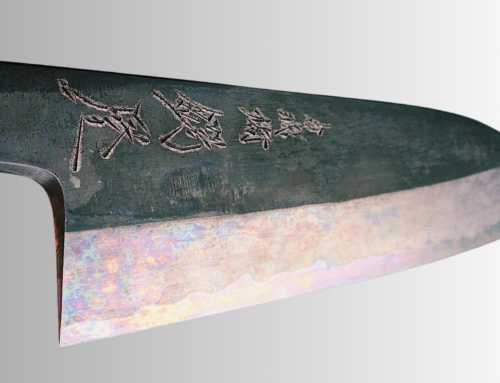Japanese knives are made by combining the perfect balance of carbon and steel in order to make knives that are durable and sharp. Sharpness is important when you are in the kitchen preparing food for your family, but you don’t want your knives to break after one fall. Japanese knives are known for both their beauty and functionality, making them preferred in kitchens all over the world.
Japanese kitchen knives are typically made from high-carbon stainless steel, with some of the most popular types being Ginsan-3, Ginsan-1, AUS-10, VG-10 and White #2 steel.
- High-carbon stainless steel: This type of steel is a combination of high-carbon steel and stainless steel. It is known for its sharp edge, good edge retention, and resistance to rust and stains.
- VG-10 steel: This is a high-performance stainless steel made in Japan. It is known for its excellent edge retention, corrosion resistance and its ability to take a very sharp edge.
- Damascus steel: This is a type of steel made by layering different types of steel together and then forge welding them. The resulting steel has a unique pattern and is known for its beauty and sharpness.
- AUS-8 steel: This is a Japanese steel that is known for its good balance of edge retention and ease of sharpening.
All of the above mentioned steels are excellent options for Japanese kitchen knives, but it is always important to consider the knife’s intended use, skill of user and personal preference as well.
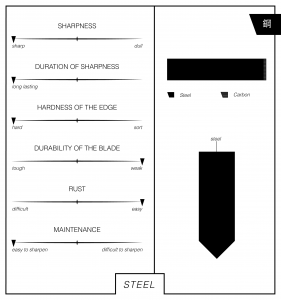
STEEL
Steel is an alloy of iron and carbon, with small amounts of other elements such as nickel, chromium, and molybdenum. It is a strong, durable, and versatile material that is widely used in many industries, including knife manufacturing.
In knife manufacturing, steel is used to make the blade of the knife. The blade is the most important part of a knife, as it is responsible for cutting and slicing. Different types of steel are used to make knives, each with its own unique properties and characteristics.
The manufacturing process of knife blade mainly includes forging, heat treatment, grinding and polishing. The steel is first heated to a high temperature, then shaped into the desired shape by hammering, pressing or other methods. After the blade is shaped, it is then heat treated to improve its properties such as hardness, toughness and corrosion resistance. The blade is then ground and polished to achieve the desired edge geometry and finish.
It’s worth noting that the quality of the knife is not only determined by the steel used but also by the manufacturing process. A well-crafted knife made from high-quality steel will perform better than a poorly made knife made from the same steel.
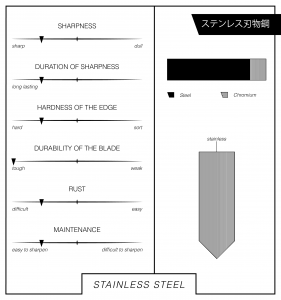
STAINLESS STEEL
White #2 [59-61 HRC]
Also known as Shirogami #2, is a type of high-carbon steel used in Japanese knives and other cutting tools. It is known for its ability to hold a sharp edge, as well as its good wear resistance and corrosion resistance.
White #2 steel is made from a high percentage of carbon, which gives it its hardness and ability to hold a sharp edge. It also contains small amounts of other elements such as manganese, silicon, and phosphorus. These elements help to improve the steel’s strength and toughness.
Silver-3 (Ginsan) [59 HRC]
This steel is about 0.95-1.1% of carbon, 13-14.5% of chromium, 0.6-1.0% of manganese, 0.5% of nickel, 0.35% of silicon and hardness 59 HRC.

VG-10 STAINLESS STEEL
VG10 steel is a type of high-carbon stainless steel that is commonly used in the production of knives and other cutting tools. It is a Japanese steel that is known for its excellent edge retention and overall sharpness. It is also a popular choice for use in high-end kitchen knives due to its ability to maintain a sharp edge for a long period of time. The chemical composition of VG10 steel typically includes carbon, chromium, molybdenum, vanadium, cobalt, and manganese.
VG-10 stainless steel is primarily focused on cutlery. The name stands for V Gold 10, indicating the quality of this steel. The approximate content is Carbon: 1%, Vanadium: .1-.3%, Chromium: 14.5-15.5%, Molybdenum: .9-1.2%, Cobalt: 1.3-1.5%, Manganese: .5%, and Phosphorus: .03%.
This steel has good edge retention and has very good corrosion resistance. Because of this, it is often used as the core, with the Damascus steel wrapped around. This steel’s poor weldability is both an advantage and a disadvantage, because it can leave an unsightly mark if welded together with other steels.
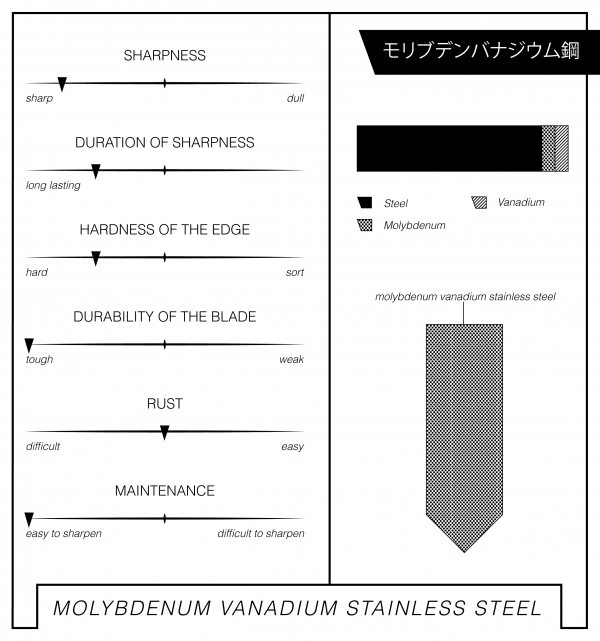
MOLYBDENIUM VANADIUM STAINLESS STEEL
AUS-10 Steel [58-61 HRC]
This steel is about 1.05% of carbon, 14% of chromium, 0.2% of molybdenum, 0.2% of vanadium, 0.5% of manganese, 0.5% of nickel, 1% of silicon and hardness 58-61 HRC. Molybdenum / vanadium is added to ordinary stainless steel, and the hardness is strengthened more than the basic stainless steel. This blade gives you both good edge retention and rust resistance. It is a high-performance knife using a sharp and rust-resistant AUS-10 as a core material.
ZA-18 [61-63 HRC]
ZA-18 has features very similar to VG-10 steel. While VG-10 is the primary steel of the Takefu steel manufacturer, ZA-18 is made by Aichi Steel. The steels have a similar chemical composition, with ZA-18 having a slightly higher content of carbon 0.95-1.2%, chromium 17-18%, molybdenum 1-1.5% and cobalt 1.8%, and thus a little more strength, durability and corrosion resistance. The steel has been tempered to a hardness of around 61-63 HRC.
Swedish
Swedish (or Bohler-Uddeholm) is a large Austrian company manufactures the steel. Established in 1670 in Sweden, they have a long history more than 300 years. Swedish steel is typically made from iron and carbon, with small amounts of other elements such as manganese, silicon, and sulfur. The exact composition of Swedish steel can vary depending on the type of steel and the manufacturer.
For example, laminated steel, a type of Swedish steel made by sandwiching a hard steel core between softer steel layers, the hard steel core is typically made from high-carbon steel, while the softer steel layers are typically made from low-carbon steel.
Another example is Sandvik steel, which is a high-performance steel made in Sweden, it is typically made from a high percentage of chromium and other alloying elements such as molybdenum, nickel, and vanadium. These elements give Sandvik steel its excellent edge retention and corrosion resistance.
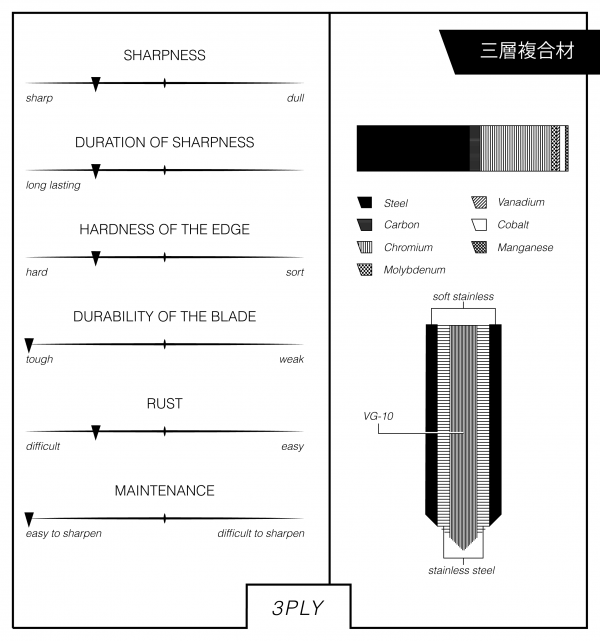
3PLY
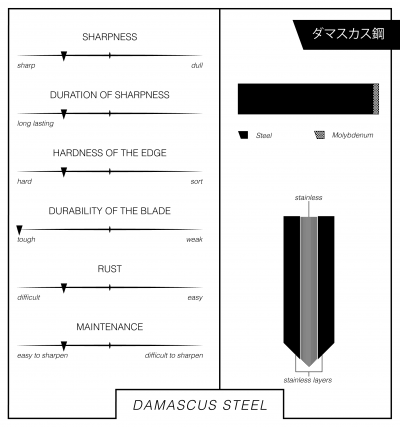
DAMASCUS
Damascus steel is a beautifully patterned steel material that was originally produced in the Damascus region of Syria since it was said to be called warts steel. The current Damascus steel produces an elegant ripple to alternately superimpose and polish two kinds of steel materials.
Often times the Damascus steel is wrapped around a core metal such as VG-10, AUS-10, Silver-3, or high-carbon steel to give the knife additional qualities, whether that be functional or aesthetic.
What is Rockwell Scale and how to understand it?

ROCKWELL SCALE
The Rockwell scale is a method of measuring the hardness of a material, including steel. Hardness is a measure of a material’s resistance to deformation, and the Rockwell scale provides a numerical value that corresponds to a material’s hardness.
The Rockwell scale uses a small indentor, or “rocker,” to press into the surface of the material being tested. The depth of the indentation is measured, and the Rockwell hardness number (HR) is calculated using a formula that takes into account the depth of the indentation and the size of the indentor.
To measure the hardness of steel using the Rockwell scale, a steel ball or a diamond cone indentor is pressed into the surface of the steel using a specific load. The Rockwell hardness number is then calculated using the depth of the indentation.
The most commonly used scales for measuring the hardness of steel are the “C” scale, which uses a 1/16″ diameter steel ball as an indentor and measures a hardness range of 20-70 HRC, and the “B” scale, which uses a 1/16″ diameter diamond cone indentor and measures a hardness range of 20-100 HRB.
It’s important to note that the Rockwell hardness test is only an approximation of steel hardness and it does not take into account all the factors that may affect the steel’s resistance to deformation. Also, different types of steel will require different Rockwell scale to measure their hardness. For example, high carbon steel will be measured on C-Scale while lower carbon steel will be measured on B-Scale. It’s also important to note that Rockwell hardness test is a surface-only test and does not give information about the toughness, ductility or any other properties of the steel.

